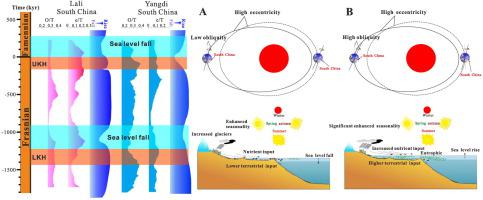Global and Planetary Change ( IF 4.0 ) Pub Date : 2022-06-22 , DOI: 10.1016/j.gloplacha.2022.103874 Kunyuan Ma , Linda Hinnov , Xinsong Zhang , Yiming Gong

|
One of the five great mass extinctions of the Phanerozoic is the Frasnian–Famennian (F F) mass extinction, for which the causes have not yet been identified. In this study, cyclostratigraphic analysis of two F
F) mass extinction, for which the causes have not yet been identified. In this study, cyclostratigraphic analysis of two F F transition sections was carried out in South China: the Yangdi section, a marine slope facies, and the Lali section, a marine basin facies. Paleoclimate proxy data collected at high resolution along these sections include magnetic susceptibility and X-ray fluorescence geochemistry (Ca and Fe concentrations). Time series analysis and modeling of the proxy data reveal that frequencies comparable to those of the Earth's long and short orbital eccentricity, obliquity, and precession index characterize the two successions. Metronomic 405-kyr long orbital eccentricity cycles identified along the two sections were used to construct a floating astronomical time scale across the F
F transition sections was carried out in South China: the Yangdi section, a marine slope facies, and the Lali section, a marine basin facies. Paleoclimate proxy data collected at high resolution along these sections include magnetic susceptibility and X-ray fluorescence geochemistry (Ca and Fe concentrations). Time series analysis and modeling of the proxy data reveal that frequencies comparable to those of the Earth's long and short orbital eccentricity, obliquity, and precession index characterize the two successions. Metronomic 405-kyr long orbital eccentricity cycles identified along the two sections were used to construct a floating astronomical time scale across the F F transition, revealing that 1000 kyr separates the Lower and Upper Kellwasser horizons (LKH and UKH), and ~1600 kyr separates the maximum values of the LKH and UKH δ13C excursions. The estimated duration of the UKH is 150 kyr, during which the first, second, and third extinctions of the F
F transition, revealing that 1000 kyr separates the Lower and Upper Kellwasser horizons (LKH and UKH), and ~1600 kyr separates the maximum values of the LKH and UKH δ13C excursions. The estimated duration of the UKH is 150 kyr, during which the first, second, and third extinctions of the F F biotic crisis lasted 120 kyr, 20 kyr, and 10 kyr, respectively. Sedimentary noise models of the magnetic susceptibility and Ca concentration time series indicate that changes in sedimentary noise correspond to sea level variations. Modeling suggests that the long orbital eccentricity cycles controlled sea surface temperatures, and that third-order eustatic changes were forced by the combined orbital eccentricity and obliquity variations. Finally, we propose an “astronomical climate change” model as a defining mechanism of the F
F biotic crisis lasted 120 kyr, 20 kyr, and 10 kyr, respectively. Sedimentary noise models of the magnetic susceptibility and Ca concentration time series indicate that changes in sedimentary noise correspond to sea level variations. Modeling suggests that the long orbital eccentricity cycles controlled sea surface temperatures, and that third-order eustatic changes were forced by the combined orbital eccentricity and obliquity variations. Finally, we propose an “astronomical climate change” model as a defining mechanism of the F F biotic crisis.
F biotic crisis.
中文翻译:

天文气候变化引发华南晚泥盆世生物和环境事件
显生宙五次大灭绝之一是弗拉斯期-法门尼期(F  F)大灭绝,其原因尚未确定。在本研究中,对两个 F
F)大灭绝,其原因尚未确定。在本研究中,对两个 F 华南地区进行了F过渡断面:洋地断面为海相斜坡相,拉里断面为海相盆地相。沿这些剖面以高分辨率收集的古气候代理数据包括磁化率和 X 射线荧光地球化学(Ca 和 Fe 浓度)。代用数据的时间序列分析和建模表明,与地球长短轨道偏心率、倾角和岁差指数相当的频率是这两个序列的特征。沿着两个部分确定的节拍式 405 kyr 长轨道偏心率循环被用于构建跨越 F 的浮动天文时间尺度
华南地区进行了F过渡断面:洋地断面为海相斜坡相,拉里断面为海相盆地相。沿这些剖面以高分辨率收集的古气候代理数据包括磁化率和 X 射线荧光地球化学(Ca 和 Fe 浓度)。代用数据的时间序列分析和建模表明,与地球长短轨道偏心率、倾角和岁差指数相当的频率是这两个序列的特征。沿着两个部分确定的节拍式 405 kyr 长轨道偏心率循环被用于构建跨越 F 的浮动天文时间尺度 F 过渡,揭示了 1000 kyr 将下 Kellwasser 层位和上层 Kellwasser 层位(LKH 和 UKH)分开,而 ~1600 kyr 将 LKH 和 UKH δ 13 C 偏移的最大值分开。UKH 的估计持续时间为 150 kyr,在此期间 F 的第一次、第二次和第三次灭绝
F 过渡,揭示了 1000 kyr 将下 Kellwasser 层位和上层 Kellwasser 层位(LKH 和 UKH)分开,而 ~1600 kyr 将 LKH 和 UKH δ 13 C 偏移的最大值分开。UKH 的估计持续时间为 150 kyr,在此期间 F 的第一次、第二次和第三次灭绝 F 生物危机分别持续了 120 kyr、20 kyr 和 10 kyr。磁化率和 Ca 浓度时间序列的沉积噪声模型表明,沉积噪声的变化对应于海平面的变化。建模表明,长轨道偏心率周期控制了海面温度,并且三阶海平面变化是由轨道偏心率和倾角变化的组合所推动的。最后,我们提出了一个“天文气候变化”模型作为 F
F 生物危机分别持续了 120 kyr、20 kyr 和 10 kyr。磁化率和 Ca 浓度时间序列的沉积噪声模型表明,沉积噪声的变化对应于海平面的变化。建模表明,长轨道偏心率周期控制了海面温度,并且三阶海平面变化是由轨道偏心率和倾角变化的组合所推动的。最后,我们提出了一个“天文气候变化”模型作为 F  F 生物危机的定义机制。
F 生物危机的定义机制。











































 京公网安备 11010802027423号
京公网安备 11010802027423号